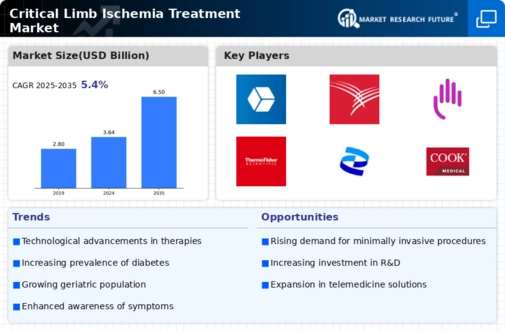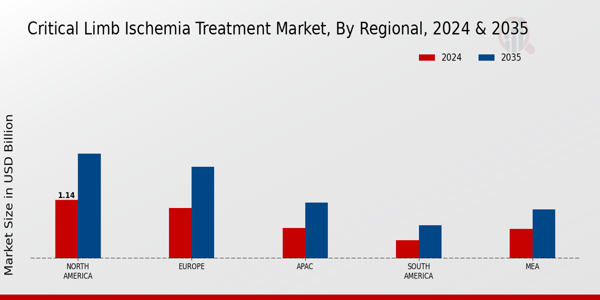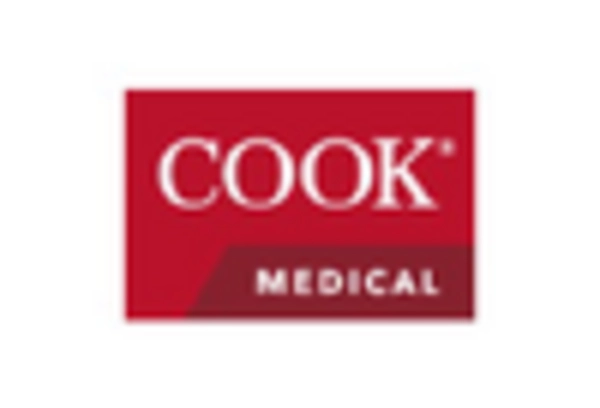Regulatory Support for Innovative Therapies
Regulatory support for innovative therapies is emerging as a significant driver for the Critical Limb Ischemia Treatment Market. Regulatory bodies are increasingly recognizing the need for expedited approval processes for novel treatment options, particularly those that demonstrate substantial clinical benefits. This support is crucial for bringing new therapies to market more rapidly, thereby addressing the urgent needs of patients suffering from critical limb ischemia. For instance, the introduction of breakthrough therapy designations has facilitated faster access to promising treatments. Additionally, the collaboration between regulatory agencies and industry stakeholders fosters an environment conducive to innovation. As more innovative therapies receive regulatory approval, the market is likely to witness an influx of new treatment options, enhancing competition and improving patient outcomes.
Increased Awareness and Screening Initiatives
Heightened awareness regarding critical limb ischemia and its associated risks is a crucial driver for the Critical Limb Ischemia Treatment Market. Public health campaigns aimed at educating individuals about the symptoms and consequences of limb ischemia have led to increased screening and early diagnosis. This proactive approach is essential, as early intervention can significantly improve patient outcomes and reduce the need for more invasive treatments. Moreover, healthcare providers are increasingly implementing screening programs for at-risk populations, such as those with diabetes or a history of cardiovascular disease. The rise in awareness not only encourages patients to seek medical attention sooner but also fosters a greater demand for effective treatment options, thereby stimulating market growth. As awareness continues to expand, the market is likely to experience a corresponding increase in treatment adoption.
Rising Prevalence of Peripheral Artery Disease
The increasing incidence of peripheral artery disease (PAD) is a primary driver for the Critical Limb Ischemia Treatment Market. As the population ages, the prevalence of PAD, which often leads to critical limb ischemia, is expected to rise. According to recent estimates, approximately 8 to 12 million individuals in the United States alone are affected by PAD, with a significant portion progressing to critical limb ischemia. This growing patient population necessitates advanced treatment options, thereby propelling market growth. Furthermore, the correlation between lifestyle factors such as smoking, diabetes, and obesity with PAD suggests that the demand for effective treatment solutions will continue to escalate. Consequently, healthcare providers are increasingly focusing on innovative therapies and interventions to address this urgent health concern.
Growing Investment in Healthcare Infrastructure
The expansion of healthcare infrastructure is a pivotal driver for the Critical Limb Ischemia Treatment Market. Governments and private entities are investing significantly in healthcare facilities and services, particularly in regions with high incidences of cardiovascular diseases. This investment is crucial for enhancing access to advanced treatment options for critical limb ischemia. Improved healthcare infrastructure facilitates the establishment of specialized centers for vascular care, which are essential for delivering comprehensive treatment. Additionally, the integration of multidisciplinary teams in these centers ensures that patients receive holistic care, addressing both the medical and lifestyle factors contributing to their condition. As healthcare systems evolve and expand, the demand for innovative treatment solutions is expected to rise, further propelling market growth.
Technological Advancements in Treatment Modalities
Technological innovations in treatment modalities are significantly influencing the Critical Limb Ischemia Treatment Market. The advent of minimally invasive procedures, such as endovascular therapies, has transformed the landscape of limb ischemia management. These techniques not only reduce recovery times but also minimize complications associated with traditional surgical approaches. For instance, the use of drug-eluting balloons and stents has shown promising results in improving blood flow and reducing restenosis rates. Additionally, advancements in imaging technologies facilitate better diagnosis and treatment planning, enhancing patient outcomes. As these technologies continue to evolve, they are likely to attract investment and research, further driving market growth. The integration of artificial intelligence in treatment protocols also holds potential for optimizing patient care and outcomes.


















Leave a Comment